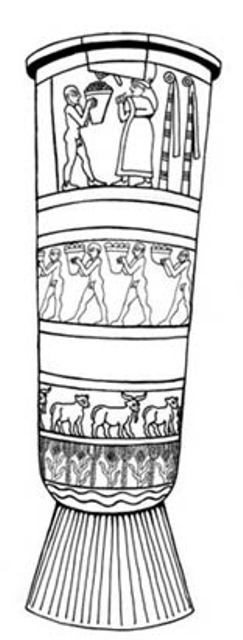ishtartv.com- ancient-origins.net + sumer2sargon.blogspot
'Bridegroom, dear to my heart; goodly is your beauty,
honeysweet; lion, dear to my heart'. These are the passionate words of a lover
to a king, from more than 4,000 years ago, in the oldest known love poem ever
found.
The loving words were passed down over generations,
eventually inscribed on an 8th century BC Sumerian cuneiform tablet small
enough to fit in the palm of one’s hand. It was uncovered in the 1880s in
Nippur, a region in what is now Iraq, and has been held by The Istanbul Museum
of the Ancient Orient ever since.
Historians say the words were recited by a bride of Sumerian
King Shu-Sin, fourth ruler of the Third Dynasty of Ur, who reigned between 2037
and 2029 BC, and used as a script for a ceremonial recreation of the sacred
marriage. It would have been sung at the New Year festival, and at banquets and
festivals accompanied by music and dance.
The full translation of the poem is as follows:
Bridegroom, dear to my heart,
Goodly is your beauty, honeysweet,
Lion, dear to my heart,
Goodly is your beauty, honeysweet.
Bridegroom, let me caress you,
My precious caress is more savory than honey,
In the bedchamber, honey-filled,
Let me enjoy your goodly beauty,
Lion, let me caress you.
My precious caress is more savory than honey.
Bridegroom, you have taken your pleasure of me,
Tell my mother, she will give you delicacies,
My father, he will give you gifts.
You, because you love me,
Give me pray of your caresses,
My lord god, my lord protector,
My SHU-SIN, who gladdens ENLIL's heart,
Give my pray of your caresses
According to the Sumerian belief, it was a sacred duty for
the king to marry a priestess every year in order to make the soil and women
fertile. The ritual of sacred marriage involved the re-enactment of the union
of two deities, usually Inanna/Ishtar and Dumuzi/Tammuz. Thus, the priestess
represented Inanna, the goddess of fertility and sexual love, while the king
represented Dumuzi, on the eve of their union.
J. Stuckey (2005) describes the ritual of the sacred
marriage:
From extant hymns, we can piece together what happened in
the ritual. First, Inanna was bathed, perfumed, and adorned, while Dumuzi and
his retinue processed towards her shrine. The famous Uruk vase may represent
this procession. All the while, temple personnel sang love songs, many of which
are extant. Resplendent Inanna greeted Dumuzi at the door, which, on the Uruk
vase, is flanked by her signature standards (gateposts), and there he presented
her with sumptuous gifts. Subsequently, the pair seated themselves on thrones,
although sometimes the enthronement took place only after sexual consummation.
The deities entered a chamber fragrant with spices and decorated with costly
draperies. Lying down on a ceremonial bed constructed for the occasion, they
united in sexual intercourse. Afterwards, pleased by and with her lover, Inanna
decreed long life and sovereignty for him and fertility and prosperity for the
land.
Muazzez Hilmiye Cig, a retired historian at the Museum, who
worked with Professor Samuel Noah Kramer in 1951 to identify and translate the
text, explained that the Sumerians “believed that only love and passion could
bring them fertility, and therefore praised pleasures”.
In the agriculture-based Sumerian community, she said,
lovemaking between the king and the priestess would have been seen as a way to
ensure the fertility of their crops, and therefore the community's welfare, for
another year.
References
Shu-Sin – Encyclopaedia
Britannica
The Oldest Love Poem – Istanbul Archaeological Museums
Inanna and the "Sacred Marriage" – J. Stuckey
(2005), Matrifocus
The Oldest Line in the World – New York Times
- See more at:
http://www.ancient-origins.net/ancient-places-asia/4000-year-old-sumerian-love-poem-and-sacred-ritual-marriage-001953#sthash.IARdIe4s.dpuf

Uruk Vase, with procession of naked priests carrying gifts to Inanna s shrine. Inanna greeting them at its door marked by her gateposts. Alabaster. 3. Uruk, Mesopotamia. Fourth millennium BCE. Credit: S. Beaulieu
|